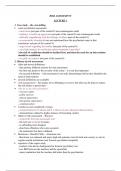College aantekeningen
Risk Assessment (Lecture Notes)
- Instelling
- Tilburg University (UVT)
Lecture notes for the course Risk Assessment. Contains elaborations on the slides and some pointers regarding what is needed for the exam (e.g., what info about each tool is important from the slides). With these notes and the slides, I got a 10 on the final exam.
[Meer zien]




